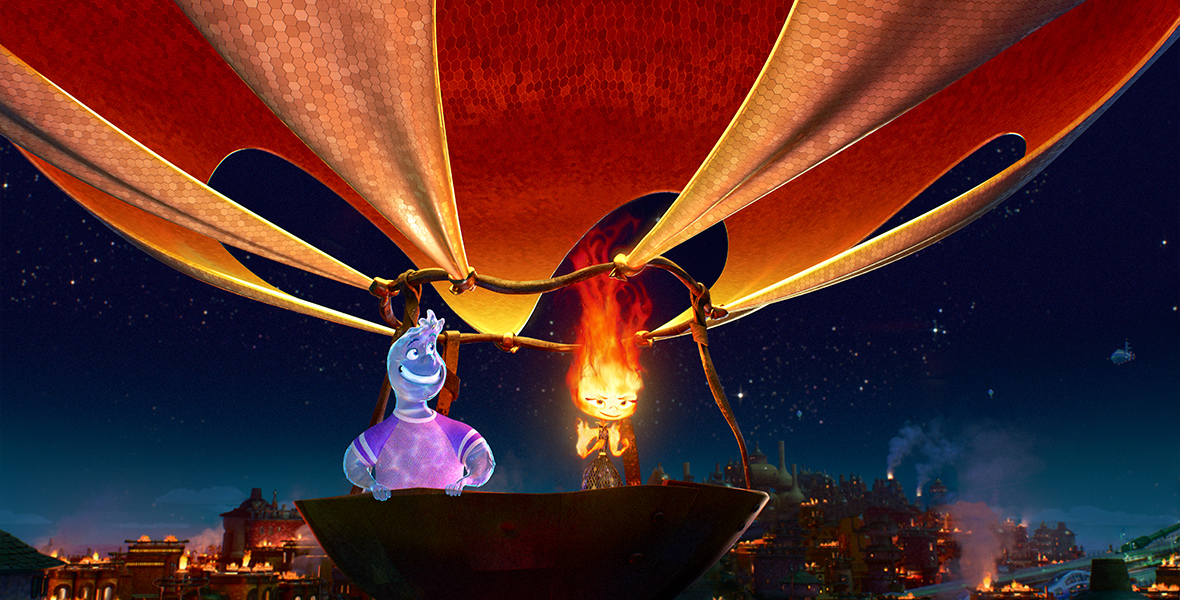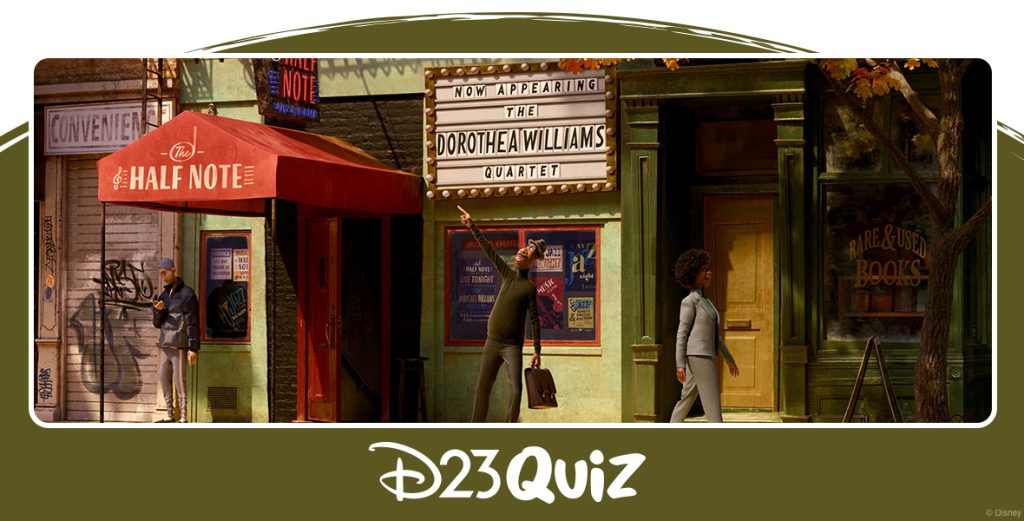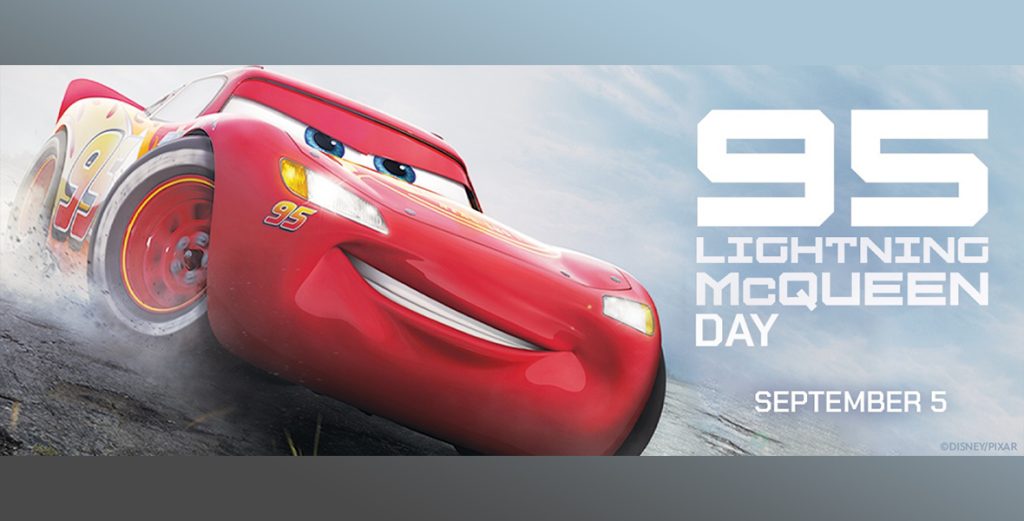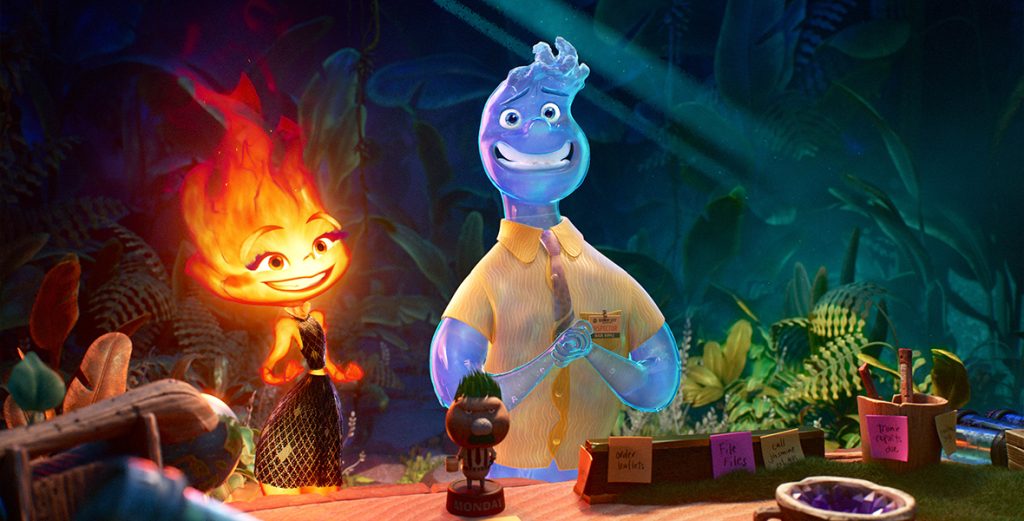By Bruce C. Steele
Like any visitor to a fabulous new metropolis, moviegoers will eagerly drink in all the colorful sights and enticing sounds of Element City from the very start of Elemental, Disney and Pixar’s new feature. There’s so much to see and hear: airships, floating trains, skyscrapers. Viewers see this bustling urban landscape at first through the eyes of Fire people Bernie and Cinder, an immigrant couple newly arrived in the port city from faraway Fireland. They’ve come to find a new life among the communities already well established in Element City: the Water people who founded the town, and the Earth and Air people who arrived soon after.
The story focuses on Bernie and Cinder’s daughter, the hot-headed Ember (voiced by Leah Lewis), who is poised to take over her father’s corner store—if she can just control her temper long enough. “I relate to her in many different ways,” Lewis said at a virtual press conference earlier this week. “Although I don’t get as angry as she does, when I was younger, I used to. These days I’ve reeled it in a little bit.”
At a moment of crisis, Wade (voiced by Mamoudou Athey) pours into Ember’s life—one of those Water people her parents have long warned her about. The unlikely partnership they forge may rescue Ember’s parents’ shop from being shut down—and teach them a lot about themselves.
At the same time, Elemental is a head-turning travelogue through Element City: its fountains and parks, its splashy condos and sunken treasures, and its residents’ communal fun and intimate interactions. (Pay no attention to that Earth couple doing a little mutual pruning.) “Honestly, I find something new every single time I watch the movie,” said producer Denise Ream.
So moviegoers might need some advance suggestions on what to look out for on this journey. At the press conference, Ream and Lewis were joined by Athey, director Peter Sohn, and songwriter Ari Leff aka Lauv, who performs and co-wrote the original song “Steal the Show” for the film. All offered suggestions on moments and emotions with which viewers will want to connect.
The hazards of proximity
In Ember’s and Wade’s first meeting, look for all the ways they work to avoid getting close. “In the beginning, you see why Fire and Water don't really get along,” Lewis says. “A lot is at stake for them just even interacting—they could literally extinguish one another, and that’s a pretty big thing.”
Lighten up
Elemental has its serious moments and may call for tissues before it’s over, but Athey assured moviegoers that the Pixar humor is in abundant supply. “You can count on Pixar to make you laugh,” he explains, “and I think this movie is hilarious. It’s really fun. You can always count on Pixar for the heart too, so go see this movie and you’ll get what you’re looking for.”

Unprecedented animation
Ember and the other Fire people have faces and bodies made of roiling flame, while Water people are transparent and undulate a bit even when standing still. They look entirely natural on-screen, but it took a lot of technical trial and error to get there.
“There were no roads at Pixar to make characters like this,” Sohn admits. “We were so used to building toys or metal cars that trying to create a character that was entirely an effect was all new for the studio. So we had to bring a lot of construction workers to build this road for us, even to get to an image that would come alive and emote—before we could even talk about moving it. It took hundreds of amazing artists.”
He continues, “The average Pixar character has about 4,000 controls, which sounds like a lot, right? But both Ember and Wade were close to 10,000. There were so many layers of effects going on with these characters that they kept multiplying the challenges in every direction we would go.”
Seeing what’s missing
One lighting effect that typically adds to the realism of CG characters is missing from Ember, Sohn reveals. “You know, you can’t shadow fire. So she remained essentially the same in every shot.” That meant checking each Ember segment for her own, unique emotional authenticity, asking, as Sohn says, “Can we read her face; the landscape of those emotions?”
Wade’s face had completely different effects, he adds. “Water requires these [added] ingredients to feel like water,” including bluish hues, pliable shapes, and rising bubbles. “If you slowed down the bubbles, all of a sudden the water would look like gelatin. If you remove the highlights, a Water person would look like a ghost.” With the lighting changing from the darkness of a basement to the sparkle of a sunlit roof, “every shot was a challenge.”
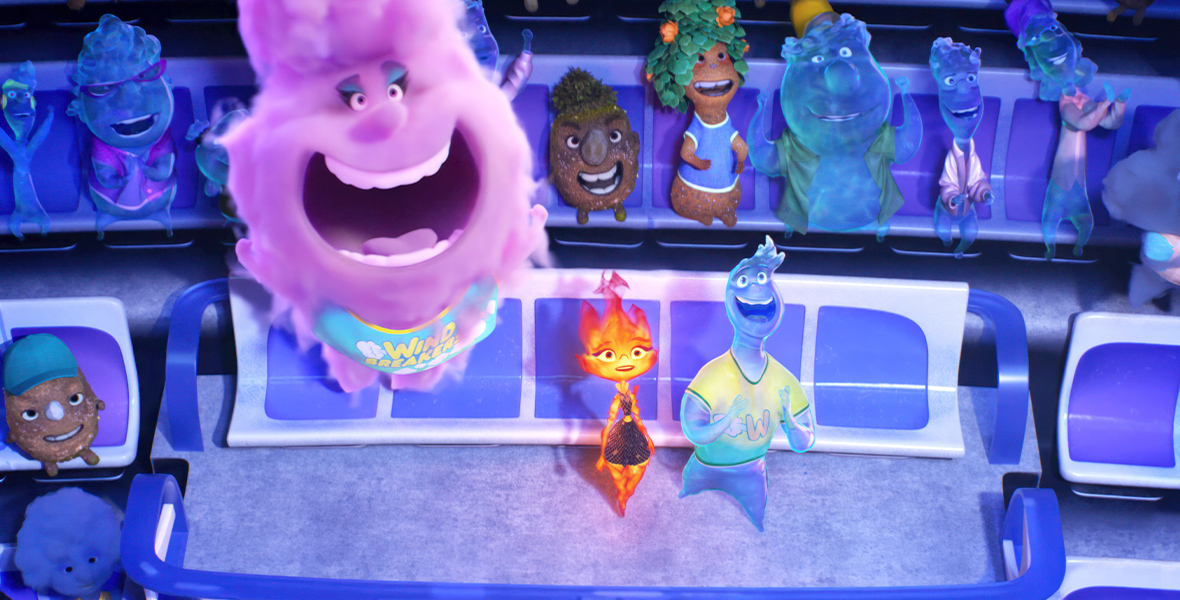
Drink in the settings
It’s easy to focus on the growing attachment between Ember and Wade, and their quest to save her family’s market, Fireplace—but don’t miss the incredible sets around them. Playing tour guide for a moment, Ream urges viewers to appreciate the “the richness the City Hall area—our garden district. Fireplace is in Firetown, and Wade’s family lives in this beautiful penthouse-pool apartment. And we get to go to Cyclone Stadium [pictured above] to watch a fantastic sporting event. There’s just a lot of really great dazzling imagery to explore.”
Within this gorgeous cityscape, Sohn and his filmmaking team have staged a number of “set pieces” worthy of any summer blockbuster. Without spoiling the visual surprises, Ream teases, “there’s a sequence we call The Hot Air Balloon that I think is really, really beautiful. [See the photo at the top of this page.] And then there’s another one we call Bubble Day that has some beautiful moments. I look forward to those scenes in every screening.” In short, get your popcorn before the movie starts, since you won’t want to miss anything.
Catch an earworm
The irresistible original song, “Steal the Show,” includes elements of the film’s lush original score, by Thomas Newman. Newman and lyricist Michael Matosic collaborated on the tune with singer-songwriter Leff, who records under the name Lauv. “I started with two loops from Thomas Newman, based on some of the sounds he’s using throughout the film,” explains Leff. “And really from there it was just me writing a chord progression and melodies… just kind of freestyling, which was really, really cool.
“As a fellow composer,” Leff says of Newman, “he gave me the space to shine in the way I needed to. It was just a really beautiful collaboration. I feel like creativity was respected all around by everybody, which is really cool.”
The song is played in part during a smile-inducing montage of Ember’s and Wade’s adventures through Element City, but you’ll need to stay for end credits to enjoy the whole thing.
3-D dazzle
You may want to consider taking in a 3-D screening of Elemental, if that’s available in your local theater. “I recently got to see the film in all its 3-D glory,” Sohn reveals. “The details that were exposed in the 3-D have been really exciting for me. Like Ember’s fire—in 3-D it’s a whole new thing, because she’s transparent, and when she moves her head, all those transparencies start to parallax and give you a depth that we didn’t see when we were working in the 2-D version. I would say, check it out. You’ll be really mesmerized by the effects.”
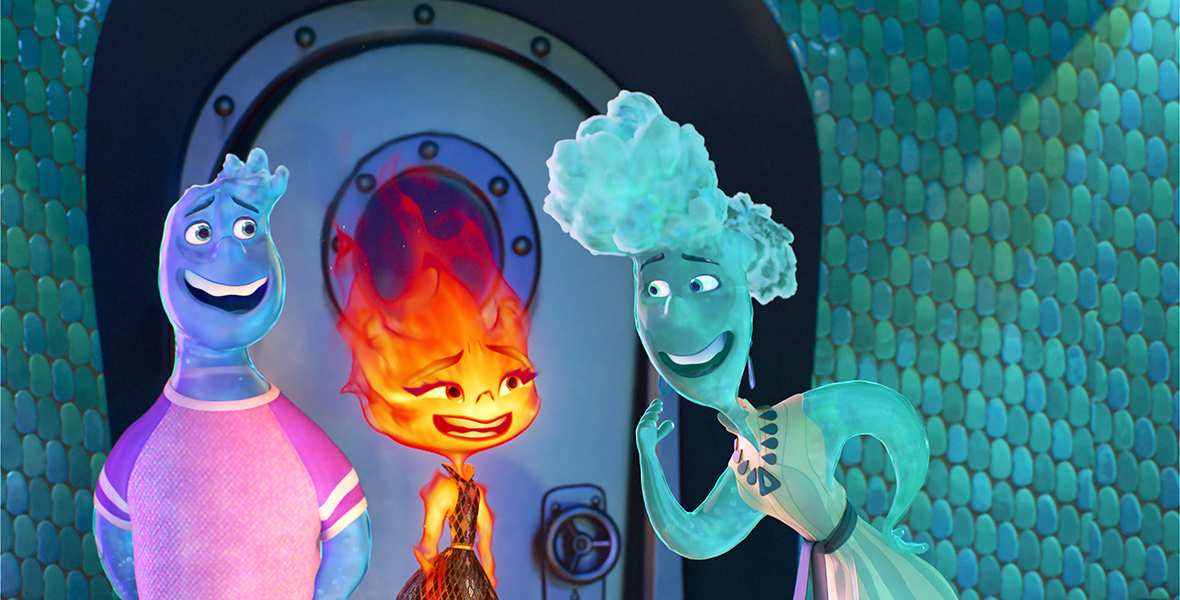
The big thank you
The themes of immigration and parenting connected Sohn with his lead performers, and the climax of the film is as much about Ember’s parents as it is about Ember and Wade. Bernie and Cinder were inspired in part by Sohn’s parents, Korean immigrants who settled in the Bronx, New York, where he was born. His lead performers have their own immigration stories: Lewis was adopted as an infant from an orphanage in Shanghai, China, while Athey arrived in the United States with his mom and diplomat dad from Mauritania when he was five months old. All three commented on how Elemental honors parental sacrifice.
“My mother and father were so supportive from a very, very early age—at about six or seven—of me wanting to pursue acting and singing,” Lewis says. Along with her sister and grandmother, her family “all put their best foot forward and rearranged their lives to help me grasp this dream.” Like Ember, she adds, “I’m deeply protective of my parents and especially as they grow older. I just I want to do as much as I possibly can for them.”
Athey’s parents’ departure from their home country—just as Bernie and Cinder left Fireland—shaped his life. “I understood that was a sacrifice as a kid,” says Athey. “But as an adult, I have a fuller understanding of what it is to build a life for yourself, and I cannot imagine having to start over for the sake of your family. But they did it. They did it for us [children]. And I think Pete shares that sense of gratitude.”
He continues, “In the making of this film and just talking about it with my parents, it’s not so much like a debt anymore. It feels more like a gift. You have to pay it forward… putting faith in yourself—the faith that they put in you.”



